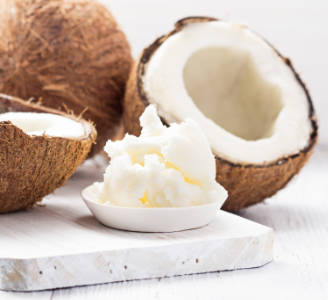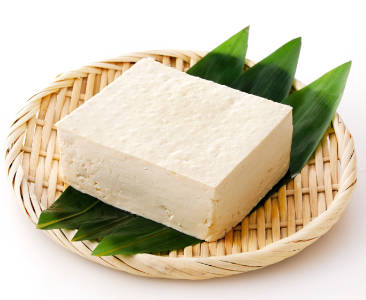Vegetarian Category

includes soy products
abura-age
These are thin slices of tofu that have been deep-fat fried. They can be cut open and filled with rice to make inari sushi, or used as a meat substitute in soups. Before using, you should blanch the cakes twice, each time with fresh water, then press the moisture out when you drain them. Abura-age is widely available in Asian markets, either in cans or fresh in cellophane packages.
Learn moreatsu-age
This is a cake of pressed tofu that has been deep-fat fried, giving it a crisp and meaty exterior and a soft interior. The Japanese like to cut it into cubes and use it in stir-fries and soups. Before using, you should blanch and drain it, then prick it with a toothpick so that it will better absorb other flavors. Atsu-age is widely available in Asian markets.
Learn moreawase miso
This is a fairly mild blend of red and white miso that's often used for vegetable soups.
Learn morebarley miso
Made from barley, it's reddish-brown in color and a bit sweeter than other dark misos.
Learn morebean stick
This is made from the skin that forms on the top of heated soy milk. It's rich in protein, and used by Chinese and Japanese cooks in soups. Look for it in Asian food stores.
Learn morecheese substitutes
Many vegetarians eat cheeses made with milk, though many insist on vegetarian cheeses made without animal rennet. Cheese substitutes, on the other hand, are designed either for people who, because of moral scruples or dietary restrictions, don't wish to consume anything made with milk, or for cost-cutters who want to scrimp on real cheese. There are many brands of cheese substitutes on the market today, and most are made with soybeans, rice, almonds and/or hemp seed. Most are made to taste something like popular milk-based cheeses like Cheddar, Mozzarella, Gouda, American, Provolone, and Jack. Cheese substitutes are blander and more rubbery than real cheeses, but many brands melt fairly well in cooked dishes, especially if grated first. Fake mozzarella comes closest in flavor and texture to the real deal. Fake cheese often contains casein or caseinates, which are derived from milk. These kinds of cheeses won't pass muster with many vegans, but they're a good choice for people trying to restrict their consumption of cholesterol and lactose. Strict vegans should seek out cheeses labeled "vegan" or "dairy-free." Unfortunately, casein is what makes cheese (real and fake alike) more elastic, so non-dairy cheeses won't pull and stretch properly when melted.
Learn morecoconut milk
This is available in liquid form (in cans or aseptic containers), frozen, and as a powder. Don't confuse coconut milk with coconut water, which is the liquid found in the center of a fresh coconut, or with the sweetened cream of coconut powder used in mixed drinks. Varieties: Light (or "lite") coconut milk has less fat and about a quarter of the calories of the regular version, but doesn't taste nearly as rich. You can reduce the fat (and calories) in a can of regular coconut milk by letting it settle, and then skimming and discarding some of the thick coconut cream off the top. Lighten what's left even more by diluting it with water or chicken broth. Where to find it: Asian foods section of many supermarkets.
Learn morecream of coconut
Don't confuse this with coconut cream, which is used in Asian dishes. Cream of coconut is thick and very sweet, and commonly used in mixed drinks. Where to find it: liquor stores, available in liquid and powdered forms.
Learn moredeep-fried tofu
Frying tofu makes it a chewier and tastier. Both the Japanese and Chinese have their own ready-made versions of deep-fried tofu, and you can find them in cellophane bags and cans in Asian markets. You can also make deep-fried tofu yourself by frying thin slabs of firm tofu in hot oil.
Learn moreextra-firm tofu
This isn't as moist as firm tofu, so it holds its shape better and absorb more flavors. Store tofu in the refrigerator, changing the water daily, and use it within a week. Freezing it will make it chewier and give it a meatier texture. Look for cakes of it in plastic tubs in the refrigerated sections of supermarkets and health food stores.
Learn morefermented bean curd
This looks innocent enough, like cubes of tofu immersed in a broth, but it has a very pungent aroma and strong, cheesy flavor. It comes in two colors. The white version is often served with rice or used to flavor soups and vegetable dishes, while the red often accompanies meats. Look for it in jars or crocks in Asian markets. Store it in the refrigerator after you've opened it, keeping the cubes immersed in liquid or oil to prevent them from drying out and discoloring.
Learn morefirm tofu
Choose this style of tofu if you want to cut it into cubes for stir-frying or crumble it into salads. Rinse and drain the tofu before you use it. Tofu will absorb more flavors and hold its shape better if you press out some of the water before marinating or cooking it. To do so, place the tofu on several layers of paper towels or cheesecloth, cover it with plastic wrap, and put something heavy on it. Do this for at least an hour, or put the whole assembly in a pan and set it in the refrigerator overnight. Store tofu in the refrigerator, changing the water daily, and use it within a week. Freezing firm tofu will make it chewier and give it a meatier texture. Look for cakes of it in plastic tubs in the refrigerated sections of supermarkets and health food stores.
Learn morehatcho miso
This is a very strong, salty version of miso that's made with soybeans and aged for up to three years. It's reddish-brown, somewhat chunky, and often used to flavor hearty soups.
Learn morehorchata
This is a Spanish beverage made with rice, almonds, or chufa. Horchatas sold in markets are often flavored with chocolate, cinnamon, or fruit. Varieties: Hispanic stores often carry almond horchata = horchata de almendra, chufa horchata = horchata de chufa, the traditional Spanish version, and rice horchata = horchata de arroz.
Learn moremiso
This is a thick paste made from soybeans and grains that has been fermented and then aged for up to three years. It's a staple in Japan, where it's used to flavor soups, dipping sauces, meats, and dressings. There are hundreds of varieties of miso, and the Japanese match them to dishes with the same care that Americans match wines to meals. The darker kinds are saltier and more pungent, the lighter are sweeter and milder. Always add miso to soups and stews at the end, since boiling it destroys beneficial bacteria and causes it to curdle. Look for tubs of miso in the refrigerated section of Japanese food markets, health foods stores, or large supermarkets. It will keep in your refrigerator for many months. Powdered miso is also available, as are powdered soup mixes made with miso and dashi.
Learn morenatto
Made with fermented soybeans, natto is pungent, sticky, and highly nutritious. The Japanese like to serve it on rice or put it in sushi or miso soups. It's available in Japanese markets or health food stores either frozen, freeze-dried, or fresh in straw bundles.
Learn morenon-dairy topping
Cool Whip and Dream Whip are popular brands. Some of these products may include casein.
Learn moreoat milk
This comes in aseptic containers. A fortified version is available that supplies many of the nutrients normally found in cow's milk. Shake well before using.
Learn moreokara
This is the ivory pulp that's left over after the soy milk is squeezed from soybeans. It's moist and crumbly, full of protein and fiber, and about as flavorful as a wad of paper towels. Look for it in the produce section of Japanese markets.
Learn morepressed tofu
With much of the moisture pressed out of it, this kind of tofu holds it shape and absorbs marinades better than firm tofu. It's the best choice for grilling.
Learn morered miso
This versatile, medium-strength miso is the most popular variety in Japan. It's made from barley or rice, and it's used for hearty soups and stews, or to make rubs and marinades for meat and poultry.
Learn moreregular tofu
This is halfway between the custard-like consistency of silken tofu and the denser texture of firm tofu. It's a good choice if you want to scramble it like eggs, or use it in place of ricotta cheese in a casserole. Store tofu in the refrigerator, changing the water daily, and use it within a week. Freezing firm tofu will make it chewier and give it a meatier texture. Look for cakes of it in plastic tubs in the refrigerated sections of supermarkets and health food stores.
Learn morerice milk
Look for this in aseptic containers. Some varieties are gluten-free; others are not. A common brand is Rice Dream. Shake well before using!
Learn moresilken tofu
This Japanese tofu is soft and creamy and it's the preferred tofu for shakes, dips, custards, puddings, and dressings. It's available either fresh in tubs or in aseptic packages that don't need refrigeration. When working with silken tofu, it's a good idea to make a dish ahead of time so as to allow the tofu to absorb other flavors. Don't freeze it.
Learn moresoft tofu
This is the Chinese version of Japan's silken tofu. Like silken tofu, it's good for making shakes, dips, custards, puddings, and dressings. Look for plastic tubs with cakes of tofu in the refrigerated sections of supermarkets and health food stores. Don't freeze this kind of tofu.
Learn moresoy cheese
Made from soy milk, soy cheese is a boon to those who eschew dairy products. There are many varieties, including those which mimic cheddar, Parmesan, mozzarella, jack, and Swiss. Most brands have a mild, ho-hum flavor and a dry texture. Except for the low-fat varieties, most of them melt fairly well.
Learn moresoy mayonnaise
This is made from soy milk, and it's a very convincing substitute for those who wish to avoid egg-based mayonnaise. Nayonaise is a well-respected brand.
Learn moresoy milk
Made from soybeans, soy milk is sweeter and darker than dairy milk, and it has a distinctive beanlike flavor. It comes refrigerated, or in aseptic containers (either full strength or concentrated), or in powdered form, with varying percentages of fat. A fortified version is available that supplies many of the nutrients normally found in cow's milk. Flavored versions are best for drinking, unflavored for cooking. Shake well before using.
Learn moresoy yogurt
This is made from soy milk, and it's a good alternative for those who wish to avoid dairy products.
Learn moresoybean paper
These colorful sheets can be used to wrap sushi. Look for them in Asian markets.
Learn moresoynut butter
This peanut butter substitute is made from roasted soynuts. It's got a bit less fat than peanut butter, and much less flavor.
Learn more





































































































































































































































































































































































